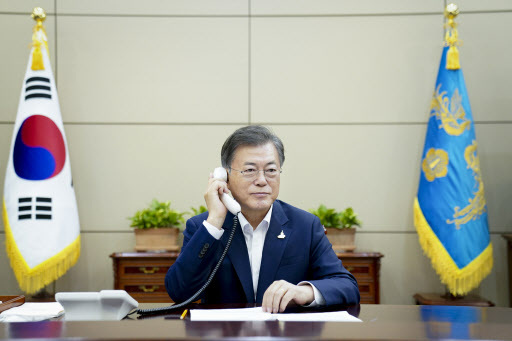Moon vows continued support for global ‘artificial sun’ project, called ITER
By YonhapPublished : July 28, 2020 - 20:11

South Korean President Moon Jae-in stated Tuesday that his country remains committed to full support for a historic international project that seeks to create an artificial sun through fusion technology.
He was speaking in a video message to a ceremony, held in Cadarache, France, to commemorate the beginning of the assembly of the world‘s largest nuclear fusion reactor, which has the potential to solve mankind’s energy needs.
South Korea is a member of the International Thermonuclear Experimental Reactor (ITER) consortium, launched in late 2006, along with the European Union, the United States, Russia, China, Japan and India.
“Today, we have a cause to celebrate, as we embark on machine assembly for the ITER,” Moon said in pre-taped remarks. “As the protection of climate and environment assumes even more importance in the wake of the outbreak of COVID-19, ITER and the member countries are presenting hope for the whole humanity.”
He called the artificial sun an “energy source of dreams.”
He also pointed out the power of international cooperation in the ITER program.
“We were able to overcome such hurdles and reach the stage of machine assembly because the seven member countries chose to pool their wisdom, with ITER playing a central role,” the president noted. “It is a proud achievement made possible by solidarity and cooperation among the international community.”
He highlighted South Korea‘s role in the process as the supplier of a massive tool, referred to as “giant,” that is tasked with assembling the most critical vacuum vessel sector of the reactor.
“Korean industries developed such vacuum vessel sectors over the course of the past decade or so, and the first sector will soon arrive at the ITER construction site,” he said. “Korea also led the way in international solidarity and cooperation through its unique brand of disease prevention measures and by sharing relevant equipment.”
Moon pledged that South Korea will continue support for the ITER project, which is likely to face more challenges ahead throughout the assembly work.
He said his government would help “more talented scientists and engineers” to participate in it.
“We will work together with the international community to realize our common dream of creating a ’clean and safe fusion energy‘ by 2050,” Moon stressed.
South Korea’s science authorities also took note of the nation‘s role.
“With the giant subassembly tool weighing 900 tons and standing 23 meters tall in place, ITER has started making the reactor with the goal of conducting a ’first plasma‘ test in December 2025,” the science ministry and the National Fusion Research Institute (NFRI) said.
NFRI chief Yoo Suk-jae said that at the assembly phase, South Korea is responsible for over 70 percent of the work, far exceeding its total share in the ITER project of 9 percent.
Besides the subassembly tool, the country is responsible for supplying the thermal shield, blanket modules for the vacuum chamber and the toroidal field coil that keeps the plasma field in place.
ITER uses deuterium and tritium as fuel, which is injected into a huge vacuum chamber and able to contain a super-hot plasma field.
The plasma field, reaching temperatures of 150 million degrees Celsius, triggers the energy-generating fusion reaction creating helium, neutron particles and heat.
If this process can be sustained, it can theoretically create an artificial sun on Earth that can provide mankind with a limitless supply of power.
Deuterium and tritium can be found in the ocean and in fresh water, with pineapple-size deuterium-tritium fuel having the same amount of energy as 10,000 tons of coal.
The ITER plant is designed for 500 megawatt output, which if connected to a power grid translates into 200 MW of electricity, enough to provide power to 200,000 households.
A scaled-up commercial version could generate 2,000 MW of electricity that can be used by 2 million households.
Proponents of ITER said the cost of building and operating a commercial nuclear fusion reactor will be similar to that of a conventional fission nuclear power unit, but it will be carbon-free and without the added expenses of waste disposal or fear of catastrophic radiation-related accidents. (Yonhap)



![[KH Explains] Hyundai Motor’s plan for new landmark keeps hitting bumps](http://res.heraldm.com/phpwas/restmb_idxmake.php?idx=644&simg=/content/image/2024/05/13/20240513050626_0.jpg&u=20240513192803)



![[Grace Kao] American racism against Stray Kids](http://res.heraldm.com/phpwas/restmb_idxmake.php?idx=644&simg=/content/image/2024/05/13/20240513050827_0.jpg&u=)



![[Graphic News] Over 80% of people filing bankruptcy in Seoul in their 50s and older](http://res.heraldm.com/phpwas/restmb_idxmake.php?idx=644&simg=/content/image/2024/05/12/20240512050205_0.gif&u=)







